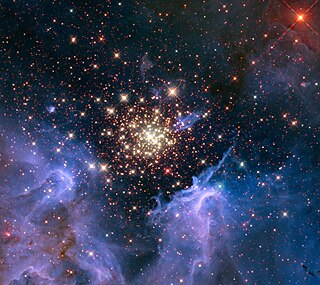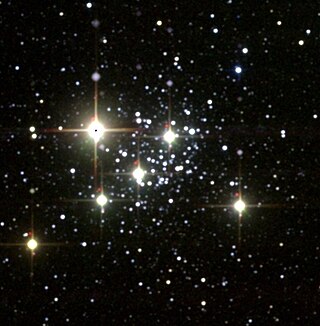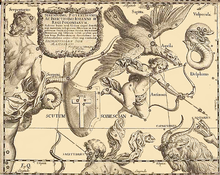
Ara is a southern constellation between Scorpius, Telescopium, Triangulum Australe, and Norma. It was one of the Greek bulk described by the 2nd-century astronomer Ptolemy, and it remains one of the 88 modern constellations designated by the International Astronomical Union.

Red supergiants (RSGs) are stars with a supergiant luminosity class and a stellar classification K or M. They are the largest stars in the universe in terms of volume, although they are not the most massive or luminous. Betelgeuse and Antares A are the brightest and best known red supergiants (RSGs), indeed the only first magnitude red supergiant stars.

Messier 26, also known as NGC 6694, is an open cluster of stars in the southern constellation of Scutum. It was discovered by Charles Messier in 1764. This 8th magnitude cluster is a challenge to find in ideal skies with typical binoculars, where it can be, with any modern minimum 3-inch (76 mm) aperture device. It is south-southwest of the open cluster Messier 11 and is 14′ across. About 25 stars are visible in a telescope with a 150–200 mm (6–8 in) aperture.

Messier 52 or M52, also known as NGC 7654 or the Scorpion Cluster, is an open cluster of stars in the highly northern constellation of Cassiopeia. It was discovered by Charles Messier in 1774. It can be seen from Earth under a good night sky with binoculars. The brightness of the cluster is influenced by extinction, which is stronger in the southern half. Its metallicity is somewhat below that of the Sun, and is estimated to be [Fe/H] = −0.05 ± 0.01.

Delta Scuti, Latinized from δ Scuti, is a variable star in the southern constellation Scutum. With an apparent visual magnitude that fluctuates around 4.72, it is the fifth-brightest star in this small and otherwise undistinguished constellation. Analysis of the parallax measurements place this star at a distance of about 199 light-years from Earth. It is drifting closer with a radial velocity of −45 km/s.

Eta Scuti, Latinized from η Scuti, is a single star in the southern constellation of Scutum, near the constellation border with Aquila. Eta Scuti was a latter designation of 9 Aquilae before the official constellation borders were set in 1922. It is visible to the naked eye as a faint, orange-hued star with an apparent visual magnitude of +4.83. This object is located approximately 213 light-years from the Sun based on parallax, and is moving closer with a radial velocity of −92 km/s.

Rho Tauri is a star in the constellation Taurus and a member of the Hyades star cluster.

Sher 25 is a blue supergiant star in the constellation Carina, located approximately 25,000 light years from the Sun in the H II region NGC 3603 of the Milky Way. It is a spectral type B1Iab star with an apparent magnitude of 12.2. Its initial main sequence mass is calculated at 60 times the mass of the Sun, but a star of this type will have already lost a substantial fraction of that mass. It is unclear whether Sher 25 has been through a red supergiant phase or has just evolved from the main sequence, so the current mass is very uncertain.

Phi Cassiopeiae is a multiple star in the constellation Cassiopeia with a combined apparent magnitude of +4.95. The two brightest components are A and C, sometimes called φ1 and φ2 Cas. φ Cas A is an F0 bright supergiant of magnitude 4.95 and φ Cas C is a 7.08 magnitude B6 supergiant at 134".
KW Sagittarii is a red supergiant star, located approximately 2,160 parsecs away from the Sun in the direction of the constellation Sagittarius. It is one of the largest known stars, with a diameter about 1,000 times larger than the Sun. If placed at the center of the Solar System, the star's surface would engulf Mars, coming close to Jupiter's orbit.

A hypergiant (luminosity class 0 or Ia+) is a very rare type of star that has an extremely high luminosity, mass, size and mass loss because of its extreme stellar winds. The term hypergiant is defined as luminosity class 0 (zero) in the MKK system. However, this is rarely seen in literature or in published spectral classifications, except for specific well-defined groups such as the yellow hypergiants, RSG (red supergiants), or blue B(e) supergiants with emission spectra. More commonly, hypergiants are classed as Ia-0 or Ia+, but red supergiants are rarely assigned these spectral classifications. Astronomers are interested in these stars because they relate to understanding stellar evolution, especially star formation, stability, and their expected demise as supernovae. A common example of a hypergiant is UY Scuti, although being a supergiant UY Scuti is considered a hypergiant by some people.
RSGC3 is a young massive open cluster belonging to the Milky Way galaxy. It was discovered in 2010 in the GLIMPSE survey data. The cluster is located in the constellation Scutum at the distance of about 7 kpc from the Sun. It is likely situated at the intersection of the northern end of the Long Bar of the Milky Way and the inner portion of the Scutum–Centaurus Arm—one of its two major spiral arms.

R Scuti is a star in the constellation of Scutum. It is a yellow supergiant and is a pulsating variable known as an RV Tauri variable. It was discovered in 1795 by Edward Pigott at a time when only a few variable stars were known to exist.

UY Scuti (BD-12°5055) is a red supergiant star, located 5,900 light-years away in the constellation Scutum. It is also a pulsating variable star, with a maximum brightness of magnitude 8.29 and a minimum of magnitude 10.56, which is too dim for naked-eye visibility. It is considered to be one of the largest known stars, with a radius estimated at 909 solar radii, thus a volume of 750 million times that of the Sun. This estimate implies if it were placed at the center of the Solar System, its photosphere would extend past the orbit of Mars or even the asteroid belt.
AH Scorpii is a red supergiant variable star located in the constellation Scorpius. It is one of the largest stars known by radius and is also one of the most luminous red supergiant stars in the Milky Way.

V520 Persei is a blue supergiant member of NGC 869, one of the Perseus Double Cluster open clusters. It is an irregular variable star. At a magnitude of 6.55, V520 Persei is the brightest member in either NGC 869 or NGC 884, although the brighter HD 13994 lies in the foreground along the same line of sight.

DU Crucis is a red supergiant and slow irregular variable star in the open cluster NGC 4755, which is also known as the Kappa (κ) Crucis Cluster or Jewel Box Cluster.

S Scuti is a carbon star located in the constellation Scutum. Parallax measurements by Hipparcos put it at a distance of approximately 1,300 light-years. Its apparent magnitude is 6.80, making it not quite bright enough to be seen with the naked eye.

NGC 7419 is an open cluster in the constellation Cepheus. It is heavily reddened and notable for containing five red supergiants, the highest number known in any cluster until the end of the 20th century, but probably no blue supergiants.



















